Science Highlights, January 21, 2015
Awards and Recognition
Earth and Environmental Sciences
Scientists support Comprehensive Nuclear-Test-Ban Treaty field inspection exercise
Materials Physics and Applications
Using ultrashort optical pulses to control magnetoelectric materials
Awards and Recognition
Batista, Boshier, Dattelbaum, Doorn, Espy, Rodriguez, Saxena, Tretiak, Yin named APS Fellows

Cristian Batista
The American Physical Society (APS) Fellows are honored for exceptional contributions to the physics enterprise; e.g., outstanding physics research, important applications of physics, leadership in or service to physics, or significant contributions to physics education. Fellowship is a distinct honor signifying recognition by one’s professional peers.
Cristian Batista (Physics of Condensed Matter and Complex Systems, T-4) was cited “For theoretical contributions to the understanding of frustrated magnetic systems, topological phases, and electronic ferroelectricity.” The APS Division of Condensed Matter Physics nominated him. Batista received a PhD in Physics from the Instituto Balseiro, Bariloche, Argentina. He joined the Laboratory in 2000. He studies strongly correlated materials, such as transition metal oxides, organic compounds, and intermetallics. His main motivation is the discovery of novel states of matter arising from the interplay between quantum mechanical effects and strong electron-electron interactions. Batista aims to find novel collective behaviors and functionalities emerging from the multiple ways in which the response of electrons in solids can be influenced by their internal spin and orbital degrees of freedom. Other awards include the Fundación José A. Balseiro Prize for the best Professor in Physics of Instituto Balseiro, LANL Postdoctoral Publication Prize in Theoretical Physics, Laboratory Fellows Research Prize, and LANL Distinguished Mentor Award.
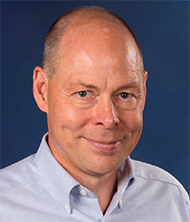
Malcolm Boshier
Malcolm Boshier (Applied Modern Physics, P-21) was cited “For high precision laser spectroscopy of hydrogen and muonium, and for advancing the state of the art in cold atom manipulation.” The APS Division of Atomic, Molecular & Optical Physics nominated him. He received a D.Phil. in atomic physics from the University of Oxford and joined the Laboratory in 2002. His atomic and optical physics research uses atoms to make better sensors to measure rotations, gravity, and magnetic fields. For many of these applications, it is best to use atoms that have been cooled extremely close to absolute zero temperature, where the atoms form a kind of giant matter wave called a Bose-Einstein condensate (BEC). In many ways a BEC is an atomic analog of the laser. Boshier and collaborators have developed some unique techniques for creating and manipulating BECs. He has received a Laboratory Small Team Distinguished Performance Award.
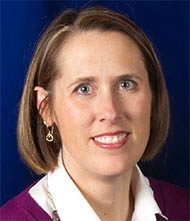
Dana Dattelbaum
Dana Dattelbaum (Shock and Detonation Physics, WX-9) was cited “In recognition of her pioneering studies of dynamic properties and excited state behavior of materials using advanced diagnostics techniques and for her leadership and service to the Society and the Shock Physics community.” The APS Topical Group on Shock Compression of Condensed Matter nominated her. She received a PhD in organic chemistry from the University of North Carolina at Chapel Hill and joined the Laboratory as a Director’s Postdoctoral Fellow in 2001. Her research interests include shock-induced chemical reactions, high-pressure chemistry, detonation initiation, equations of state, and constitutive properties of soft materials. Other awards and outstanding accomplishments include Chair of the Topical Group on Shock Compression of Condensed Matter, DOE/NNSA Defense Programs Awards of Excellence, Los Alamos Achievement Awards, LANL Star Award (2007), Reilly Fellowship, and American Chemical Society Analytical Division Undergraduate of the Year Award.
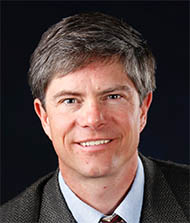
Stephen Doorn
Stephen Doorn (Center for Integrated Nanotechnologies, MPA-CINT) was cited “For his pioneering accomplishments in defining, shaping, and leading the field of spectroscopic characterization of carbon nanomaterials, including single-walled nanotubes and graphene.” The APS Division of Laser Science nominated him. Doorn earned a PhD in physical chemistry from Northwestern University, and joined the Lab in 1990 as a Director’s Postdoctoral Fellow. He studies the spectroscopy and chemistry of carbon nanomaterials including carbon nanotubes and graphene. Doorn applies Raman spectroscopy for nanotube structural identification and characterization. He has discovered novel exciton- and electron-phonon coupling behaviors. Doorn uses photoluminescence spectroscopic probes of nanotube surface chemistry and surface structures to understand new optical behaviors introduced by dopant species. He is the Partner Science Leader for the Nanophotonics and Optical Nanomaterials research thrust of the Center for Integrated Nanotechnologies. Doorn has received a LANL Fellows Prize for Research, DOE Office of Science Outstanding Mentor Award, Nanotech Briefs Nano50 Award for his role in development of ultralong carbon nanotubes, a LANL Distinguished Performance Award, and a Defense Programs Award of Excellence. He has more than 100 publications with over 3800 citations.
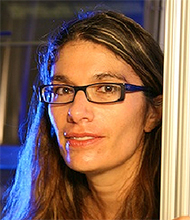
Michelle Espy
Michelle Espy (Applied Modern Physics, P-21) was cited “For the application of nuclear physics techniques to biomedical research and national security challenges. Including pioneering work in the application of ultra-low field nuclear magnetic resonance to functional brain imaging and non-invasive identification of materials for national security.” The APS Division of Nuclear Physics nominated her. Espy earned a PhD in physics from the University of Minnesota and joined the Laboratory in 1996. She investigates applications of nuclear physics to brain imaging and national security. Espy has won a R&D 100 Award and Laboratory Distinguished Performance Awards.
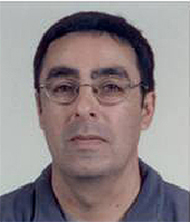
George Rodriguez
George Rodriguez (Center for Integrated Nanotechnologies, MPA-CINT) was cited “For his outstanding leadership in the development of ultrafast laser-based and high-speed optical instrumentation and his creative application of these diagnostics to the impactful measurement of materials, systems, and devices.” The APS Topical Group on Instrument and Measurement Science nominated him. Rodriguez earned a PhD in electrical engineering from the University of Illinois at Urbana-Champaign, and joined the Laboratory as a postdoctoral researcher in 1992. He studies ultrafast optical science and instrumentation with applications to spectroscopy, materials dynamics, and high-speed diagnostics.
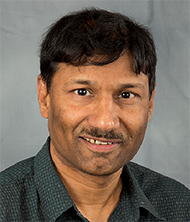
Avadh Saxena
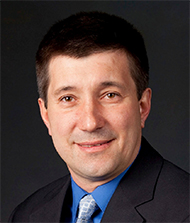
Sergei Tretiak
Sergei Tretiak (Physics and Chemistry of Materials, T-1) was cited “For seminal contributions to the theoretical chemistry of excited state dynamics in nanoscale materials and nonlinear optical response of molecular systems.” The APS Division of Chemical Physics nominated him. Tretiak received a PhD degree in chemistry from the University of Rochester. He joined Los Alamos as a Director’s Postdoctoral Fellow in 1999 and became a Technical Staff Member in 2001. Tretiak became a member of the Center for Integrated Nanotechnologies (CINT) team in 2006. His research includes the development of modern computational methods for molecular optical properties, nonlinear optical response of organic chromophores, adiabatic and non-adiabatic molecular dynamics of the excited states, optical response of confined excitons in conjugated polymers, carbon nanotubes, semiconductor nanoparticles, and molecular aggregates. Tretiak has published over 180 scientific articles cited over 6000 times. He has won a Laboratory Fellow’s Prize for Research.

Lin Yin
Lin Yin (Plasma Theory and Applications, XDP-6) was cited “For scientific leadership and landmark discovery in the theory and complex kinetic modeling of nonlinear laser-plasma interaction physics, including stimulated Raman scattering and laser-driven particle acceleration.” The APS Division of Plasma Physics nominated her. Yin received a PhD in physics from the University of California – Los Angeles. She came to Los Alamos as a Director’s Postdoctoral Fellow in 1999 and became a technical staff member in 2001, working on a variety of scientific topics, including kinetic particle simulations, novel hybrid and Hall-MHD simulation techniques, simulation studies of collisionless magnetic reconnection, slow-mode shocks, kinetic Alfvén waves, and source modeling for x-ray radiographic devices. Yin led the application of particle-in-cell modeling to a range of problems, including the study of nonlinearity in stimulated Raman and Brillouin scattering in laser-driven inertial confinement fusion (ICF) experiments, ultra-intense laser-matter interaction, and the complex, three-dimensional physics in magnetic reconnection. She has authored more than 90 refereed journal publications. Yin received the American Physical Society Katherine E. Weimer Award, conferred triennially to recognize outstanding achievement in plasma science research by a woman physicist in the early years of her career. She has received two Lab Distinguished Performance Awards and DOE Defense Programs Awards of Excellence for four years.
Bioscience
Understanding how plants have resistance to fungus
Researchers have investigated the nature of resistance of tomato plants to a fungal infection. The tomato is one of the most economically important crops and a model system for fruit development. Strains of the ascomycete fungus Fusarium oxysporum are ubiquitous soil inhabitants. F. oxysporum acts as a pathogen to cause disease in vegetables, fruit trees, wheat, corn, cotton and ornamental crops. The fungus invades plant roots to infect vascular bundles in the plant host, leading to wilt symptoms. Cliff Han (Bioenergy and Biome Sciences, B-11) and Katherine Borkovich (University of California-Riverside, UCR) led a team that examined why the tomato cultivar Moneymaker is susceptible to the fungus Fusarium oxysporum while the near-isogenic tomato cultivar Motelle is resistant to the same fungus. The journal Plos Pathogens published the work.
The team explored a possible role for tomato miRNAs in the differential resistance of Moneymaker and Motelle to F. oxysporum. The researchers conducted a genome-wide microRNA (miRNA) expression analysis to determine the differential miRNA profiles induced upon fungal infection in susceptible and resistant tomato plants. The miRNAs are single-stranded RNA molecules of approximately 20–24 nucleotides in length that are endogenously transcribed from single-stranded non-coding RNA species. miRNAs are the negative regulators of specific messenger RNAs (mRNAs) that code proteins, which determine functions of human and plant cells.
The study provides a platform for differentially expressed miRNAs in tomato after F. oxysporum infection and demonstrates that plant miRNAs are involved in defense against the fungus. The results indicate that two different miRNAs contribute to plant immunity in tomato by influencing mRNA stability or translation of at least three nucleotide-binding site domain-containing proteins distinct from the I-2 gene, the only known resistance gene for F. oxysporum in tomato. The team observed that the miRNAs that down-regulate the expression of tm-2 (a resistance protein) are underexpressed in resistant tomato and overexpressed in susceptible tomato. It is the first report of the involvement of the tm-2 protein in the fungal resistance in tomato. The authors suggest that the potential resistance of the susceptible cultivar is insufficiently expressed due to the action of miRNAs. The findings support roles for resistance genes, in addition to the I-2 gene, in the plant’s immune response.
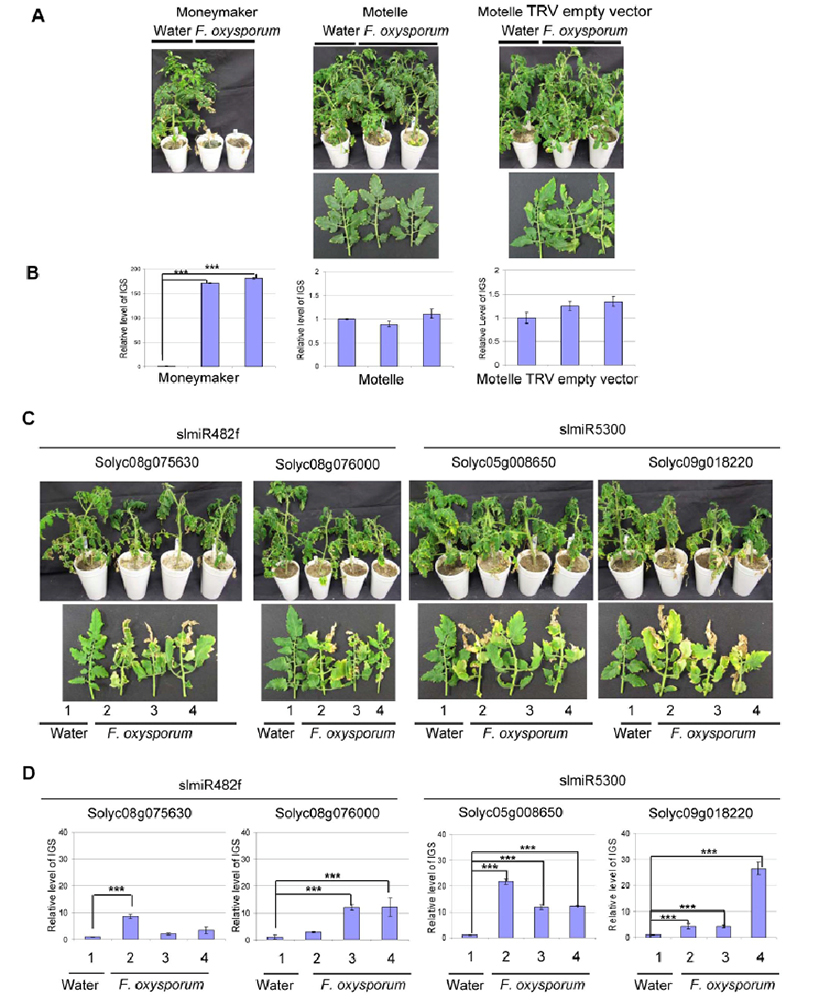
Figure 1. Targets of slmiR482f and slmiR5300 are required for F. oxysporum defense in tomato. All control and virus-induced gene silencing (VIGS) plants were cultivated together in the same growth chamber. Similar results were obtained in three biological replicates. Errors are expressed as standard error. *** indicate significant differences when compared with the corresponding control plants in the same treatments at p<0.001. (A) Phenotype of control plants infected by Fusarium oxysporum. Two-week-old seedlings of the indicated cultivars were treated with water or F. oxysporum and photographed four weeks later. Cultivars were Moneymaker (left panel), Motelle (center panel) and Motelle infected with TRV empty vector (right panel). (B) The relative level of F. oxysporum in control plants. Leaves were collected from water or F. oxysporum-treated plants and genomic DNA isolated. qPCR of the Intergenic Spacer region (IGS) of F. oxysporum was used to measure relative fungal cell loads in planta. Note the different y-axis scale for Moneymaker (left graph) vs. Motelle (center and right graphs). (C) Phenotypes of VIGS plants after infection with F. oxysporum. Motelle tomato plants were infiltrated with constructs carrying vectors that would lead to VIGS of a predicted target gene. Results for the two targets of slmiR482f are shown to the left, while the two for slmiR5300 are shown to the right. Four weeks after initiation of VIGS, roots of tomato plants were infected with F. oxysporum or treated with water (controls). Phenotypes were scored four weeks later. A water-treated control VIGS plant or a leaf is shown on the left of each panel, with three plants or leaves from F. oxysporum-infected VIGS plants to the right. (D) PCR to determine relative levels of F. oxysporum cells in leaves of VIGS plants. qPCR of the F. oxysporum rRNA intergenic spacer region was performed on genomic DNA isolated from leaves of water or F. oxysporum- infected plants as described in (B)
This combination of plant pathology and microbiology expertise of UCR and the next-generation functional genomics capability in LANL made this important discovery possible. These findings provide insight on how a pathogen subverts host defense through the down-regulation of an important tomato resistance gene. Identification of such mechanisms will be important in developing novel preventive measures, which in this case would imply up-regulation of the resistance gene.
Reference: “MicroRNAs Suppress NB Domain Genes in Tomato That Confer Resistance to Fusarium oxysporum,” Plos Pathogens 10 (10), e1004464 (2014); doi: 10.1371/journal.ppat.1004464. Authors include Shouqiang Ouyang, Gyungsoon Park, and Hagop S. Atamian (University of California-Riverside); Cliff S. Han (Bioenergy and Biome Sciences, B-11); Jason E. Stajich, Isgouhi Kaloshian, and Katherine A. Borkovich (UC-R).
The research was part of a special collaboration was between the Laboratory’s Bioscience Division and the University of California - Riverside Plant Science. The University of California Office of President funded the work to focus on the biology, diagnosis, and therapy of plant diseases. The research supports the Laboratory’s Global Security mission area and the Materials for the Future science pillar through the development of pathogen-resistant crops. Technical contact: Cliff Han
Earth and Environmental Sciences
Scientists support Comprehensive Nuclear-Test-Ban Treaty field inspection exercise
The Comprehensive Nuclear-Test-Ban Treaty (CTBT) is an agreement that bans all signatory nations from conducting nuclear tests. The CTBT has been signed by more than 180 nations, but for entry into force, all 44 countries that possessed nuclear technology in 1996 must sign and ratify the Treaty. The Treaty has not yet entered into force because a number of countries have not ratified it. In preparation for eventual ratification and entry into force, the Preparatory Commission for the Comprehensive Nuclear-Test-Ban Treaty Organization (CTBTO) conducted the 2014 Integrated Field Exercise (IFE14), a simulated On-Site Inspection, which took place in Jordan from November 3 - December 9, 2014. Lab geologist Ward Hawkins (Geophysics, EES-17) chaired the Scenario Development Group for the integrated field exercise, and other Lab scientists supported the activity.
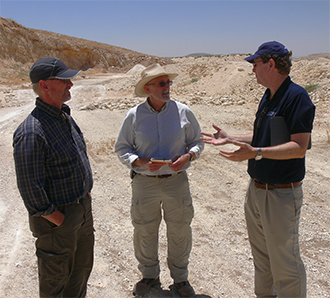
Photo. (Left to right): Ken Wohletz, Ward Hawkins, and Gordon MacLeod in the field in Jordan.
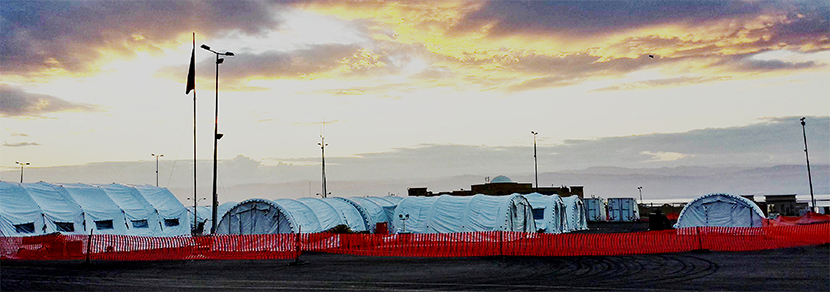
Photo. The IFE14 Base of Operations on the Dead Sea.
Materials Physics and Applications
Using ultrashort optical pulses to control magnetoelectric materials
Materials in which magnetic and electric order coexist have great potential for novel magnetoelectric devices, including applications in data storage, photovoltaics, and magnetic sensing. However, such materials are scarcely found in nature. Researchers at the Center for Integrated Nanotechnologies (CINT) aim to unravel key microscopic mechanisms that could advance a more abundant alternative—the engineering of artificial multiferroic composites at useful temperatures. The team successfully demonstrated a new approach to detect and control the coupling between electric and magnetic order on ultrafast timescales. The work reveals the dynamic properties of multiferroics, a rarely explored aspect that affects their potential applications. Nature Communications published the findings.
The team used femtosecond optical pulses to explore and optically manipulate the coupling between ferroelectric (FE) and ferromagnetic (FM) order in an oxide heterostructure for the first time. They discovered that the timescale dominating the magnetoelectric response is governed by demagnetization of the ferromagnetic layer through spin–lattice relaxation. Optically perturbing magnetic order in the ferromagnetic layer imposes lateral stress on the ferroelectric layer through magnetostriction, modifying ferroelectric order within tens of picoseconds. This finding demonstrates that femtosecond optical pulses can provide insight into the microscopic mechanisms underlying magnetoelectric coupling in complex oxide heterostructures and to manipulate the magnetoelectric response in these systems on ultrafast timescales.
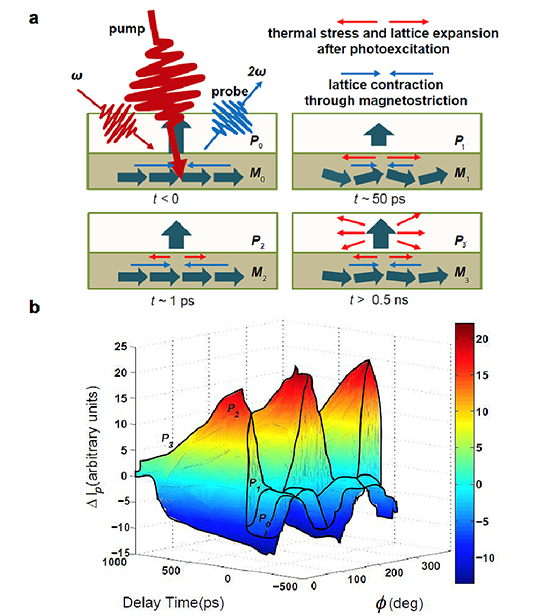
Figure 2. (a) Schematic diagram of the interplay between the lattice, the magnetization M, and the ferroelectric polarization P at different times. (b) Time-and-polarization dependent second harmonic generation signal, indicating the photoinduced changes in ferroelectric order.
Reference: “Using Ultrashort Optical Pulses to Couple Ferroelectric and Ferromagnetic Order in an Oxide Heterostructure,” Nature Communications 5, 5832 (2014); doi: 10.1038/ncomms6832. Authors include Yu-Miin Sheu (formerly with MPA-CINT), Stuart Trugman (Physics of Condensed Matter and Complex Systems, T-4), Li Yan (formerly with MPA-CINT), Quanxi Jia and Rohit Prasankumar (MPA-CINT), and Toni Taylor (Materials Physics and Applications, MPA-DO),
This work was performed at CINT, a DOE Office of Basic Energy Sciences user facility. The Laboratory’s Directed Research and Development (LDRD) program provided funding. The work supports the Lab’s Energy security mission area and the Materials for the Future science pillar. Multiferroics have potential applications, such as reducing the energy required to switch hard drives in computers. Technical contact: Rohit Prasankumar
Materials Science and Technology
Ion beam analysis textbook published
Yongqiang Wang (Materials Science in Radiation and Dynamics Extremes, MST-8) in collaboration with former Los Alamos National Laboratory researcher Michael Nastasi (now at the University of Nebraska – Lincoln) and the late Jim Mayer authored a new ion beam analysis textbook. Ion Beam Analysis: Fundamentals and Applications focuses on the fundamentals and applications of ion beam methods of materials characterization. The authors explain the basic characteristics of ion beams as applied to the analysis of materials as well as ion beam analysis of art and archaeological objects. Primarily geared to upper-level undergraduate and graduate students, the book is 450 pages with 15 chapters, and features homework problems after each chapter.
Ion Beam Analysis: Fundamentals and Applications explains how ions interact with solids and describes what information can be gained. The authors begin by covering the fundamentals of ion beam analysis, including kinematics, ion stopping, Rutherford backscattering, channeling, elastic recoil detection, particle induced x-ray emission, and nuclear reaction analysis. Then the book examines applications for a broad range of potential uses in thin film reactions, ion implantation, nuclear energy, biology, and art/archaeology. The authors discuss classical collision theory, detail the fundamentals of five specific ion beam analysis techniques, and illustrate specific applications, including biomedicine and thin film analysis.
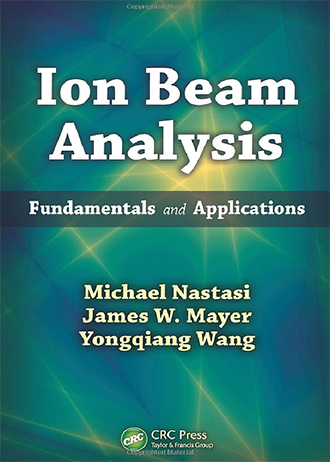
Wang leads the Ion Beam Materials Laboratory, a LANL resource devoted to materials research through the use of energetic ion beams. He serves as the acting team leader for MST-8’s Experimental Radiation Sciences team. Wang has authored or coauthored more than 200 peer-reviewed publications including 3 book chapters, 2 U.S. patents, and the Handbook of Modern Ion Beam Materials Analysis-Second Edition (MRS Publisher, 2009). He is a member of the International Committee for Ion Beam Analysis, and he co-chaired the 2014 International Conference on the Application of Accelerators in Research and Industry.
The Materials Science and Engineering Division of the DOE Office of Basic Energy Sciences and the Center for Integrated Nanotechnologies (CINT), a DOE nanoscience user facility jointly operated by Los Alamos and Sandia National Laboratories, provided funding. The research supports the Laboratory’s Materials for the Future and Nuclear and Particle Futures science pillars. Technical contact: Yongqiang Wang
Physics
Experiments on the head-on merging of supersonic plasma jets
Colliding plasmas are found in plasma systems over a vast range of scales, from the mm-scale hohlraum plasmas of inertial confinement fusion (ICF) experiments to supernova remnants in astrophysics. Colliding plasmas can be in a regime that is neither purely collisional (i.e., the particle mean-free-path is small and the plasma can be treated as a fluid) nor purely collisionless (i.e., the mean-free-path is large and classical collisions between particles can be neglected). This complicates modeling of merging-plasma behavior. The nature of many merging plasmas makes measurements difficult. Through detailed characterization of two laboratory supersonic plasma jets undergoing head-on merging, Plasma Physics (P-24) researchers have demonstrated the transition from collisionless interpenetration to collisional stagnation between two merging jets. The team attributes the transition to an increasing mean-ionization state.
Experiments performed on the Plasma Liner Experiment (PLX) facility at Los Alamos National Laboratory used a fast-framing camera to give an overview of the structure and dynamics [Figure 3(a)] of the merging plasma jets and multi-chord laser interferometry [Figure 3(b)]. Together with visible spectroscopy and spectral simulations, the results provided the experimentally inferred plasma density, temperature, and mean-ionization state.
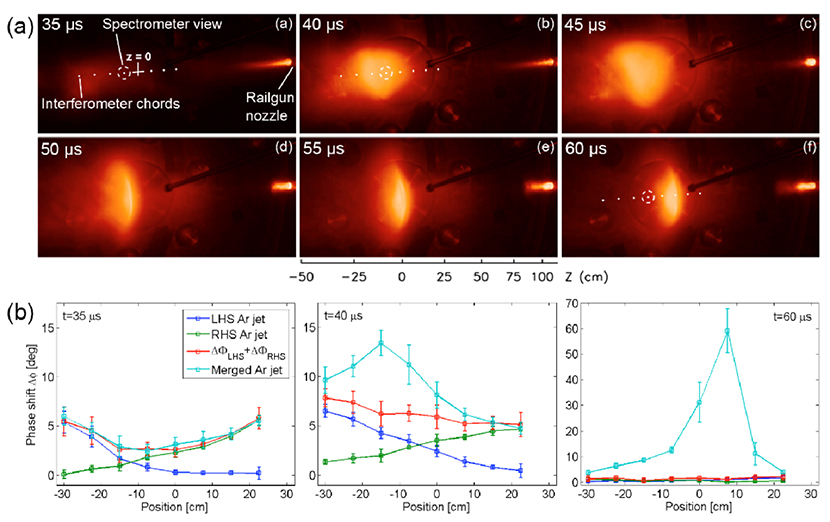
Figure 3. (a) Fast-framing camera images show the head-on jet merging interaction, a progression from simple jet interpenetration (35 µs), to interpenetration with increased ionization state (40 µs), and finally collisional stagnation and the formation of a shock (t=60 µs). (b) Interferometer phase shift indicates electron density at 8 locations along the interaction region. Measurements show simple jet interpenetration at 35 µs (left panel), interpenetration with increased ionization at 40 µs (center panel), and collisional stagnation and the formation of a shock at (right panel).
The two supersonic plasma jets initially interpenetrate [Figure 3(b), left panel], consistent with inferred inter-jet ion-ion collision lengths that are long. As the jets interpenetrate, the mean ionization state increases [Figure 3(b), center panel], possibly due to ion-impact ionization between the counter-streaming ions of each jet. The ion-ion collision length has a strong dependence on mean ionization and so drops rapidly as the mean ionization increases, leading to collisional stagnation of the jets as inter-jet collisions become frequent [Figure 3(b), right panel].
The effect of mean-ionization state on collisionality could be especially important in plasmas of mid- to high-atomic-mass species, and failing to take ionization state into account could mislead interpretation of shock structure. Specifically, shocks may be misidentified as purely collisionless. These measurements are valuable for benchmarking widely used plasma collisionality models in the presence of complex equations of state.
Former P-24 postdoctoral researcher Auna Moser (now at General Atomics) presented the research as an invited talk at the 56th Annual Meeting of the American Physical Society Division of Plasma Physics (October 27-31, 2014 in New Orleans, LA). Other researchers include principal investigator Scott Hsu, John Dunn, and Colin Adams (P-24). The Laboratory Directed Research and Development (LDRD) program funded the research. The Office of Fusion Energy Sciences of the DOE Office of Science sponsored the construction of the PLX facility. The research supports the Laboratory’s Energy Security and Nuclear Deterrence mission areas and the Nuclear and Particle Futures science pillar. Technical contact: Scott Hsu














